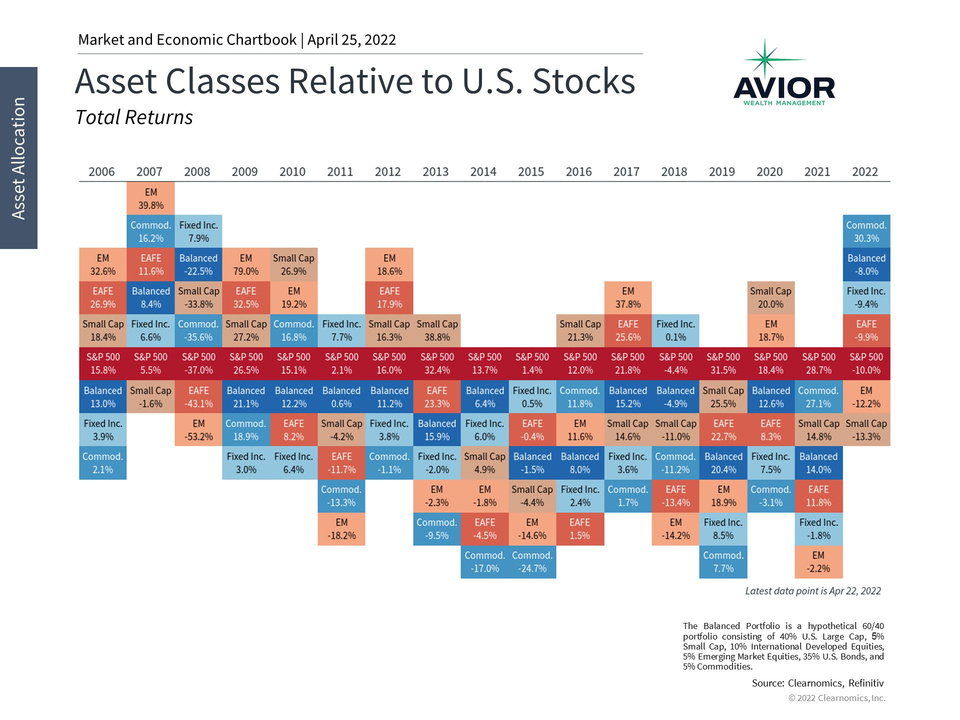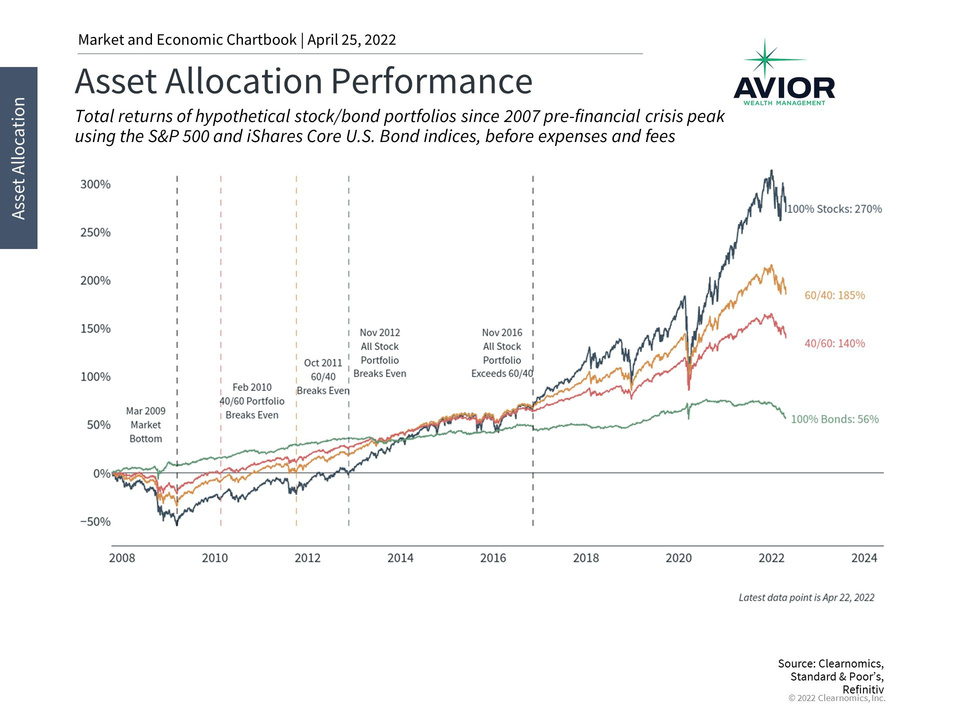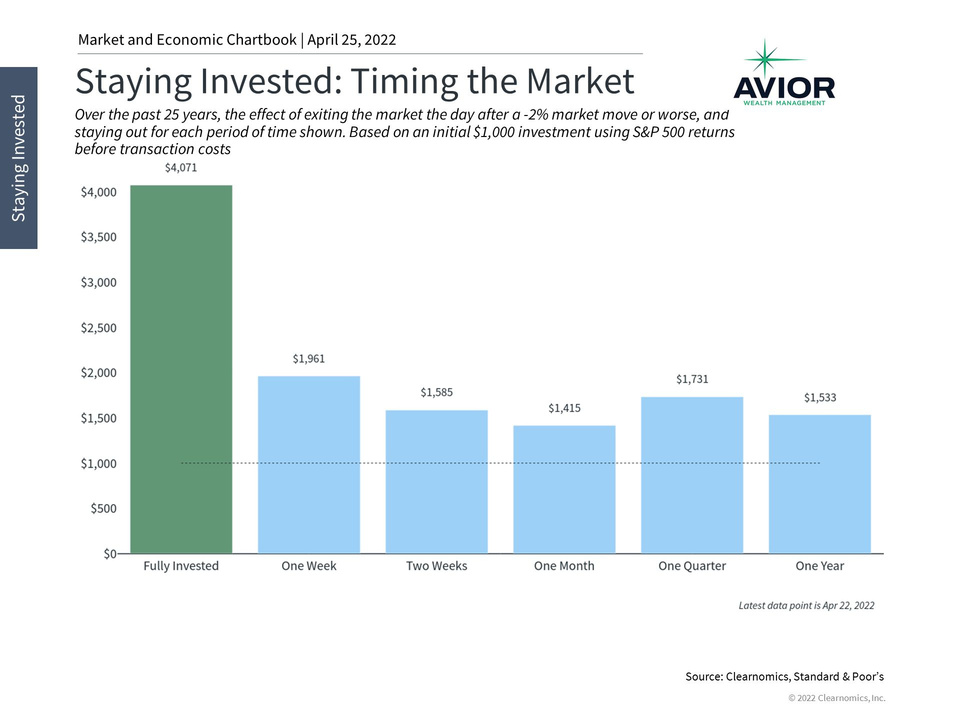AVIOR INSIGHTS – How Diversification Helps Investors in Today’s Challenging Market
For some investors, it can be challenging to balance short-term market negativity with positive long-term trends. In the near-term, rising interest rates and international concerns are once again rattling the stock market. Last Friday, the S&P 500 experienced its second-worst day since 2020 by falling 2.8%. Both the S&P 500 and the Nasdaq are in correction territory (defined as a 10% or worse decline from all-time highs) and most other asset classes have struggled this year too.
However, economic data are still coming in strong despite fears around inflation and the Fed, and many of the issues driving markets have been well understood and anticipated by investors. History also shows that declines of this size are normal for markets, even when there are seemingly insurmountable problems. Still, this dilemma may have some investors wondering whether they should abandon diversification and their investment plans altogether. How can investors stay focused amid day-to-day market swings and challenging performance this year?
Most investors intuitively understand the value of diversifying across asset classes such as U.S. stocks, fixed income, international assets, small caps, and more. The purpose of diversification is neither to outperform on any given day, week, or month, nor is it to do better than the S&P 500 or Dow in the long run. Instead, diversification is about generating healthy returns while properly managing risk. By combining different types of assets in an appropriate way, it’s possible to construct portfolios that have attributes aligned with the investor’s long-term goals.
This is important because investors who stick to their financial plans, invest for the long run, and stay diversified are more likely to achieve their financial goals. Unfortunately, those parts of the market that outperform tend to receive the most attention, leading to a temptation to chase what’s already worked even if it’s just a flash in the pan. Conversely, asset classes that underperform over a short period are often shunned by investors, even when their fundamentals are sound and could play a critical role in a portfolio.
Today, there are a few key issues driving performance across asset classes. Perhaps the biggest challenge is that interest rates spiked again last week with the 10-year Treasury yield rising as high as 2.94% before retreating. This was its highest level since 2018 and breaks the 40-year trend of falling rates.
On the one hand, sudden jumps in interest rates can have ripple effects across stock and bond markets. Not only do higher rates mean that future cash flows may be less valuable today, which hurts current asset prices, but they can also make interest-bearing assets more attractive. All told, this means there is often a shift from “riskier” stocks to “safer” bonds.
On the other hand, interest rates are still well within normal levels. In fact, prior to 2008, the 10-year Treasury yield was never as low as it is today. Even if the Fed accelerates its rate hike plans, which it is likely to do, the federal funds rate would still only be back to its trend from 2019.
Taking a broader perspective, it’s very normal for interest rates to rise during the growth phase of a business cycle. And while inflation is certainly much higher than in the past, there is no reason yet to believe that individuals, businesses, and financial markets can’t adapt to higher rates.
Another issue has to do with international concerns. The war in Ukraine continues to evolve, putting pressure on international relations, Europe, and energy prices. Additionally, China’s ongoing lockdowns amid its zero-COVID strategy could further worsen supply chain disruptions and manufacturing output. In the worst case, this could exacerbate inflation in certain goods. Chinese equities and emerging markets have struggled as a result.
At the same time, recent history in China and other parts of the world suggest that pandemic issues do resolve themselves over time. Other major problems in China, such as fears of a housing bubble bursting late last year, were also resolved by markets and government intervention. So, while there may be repercussions from strict shutdowns, these issues are not necessarily reasons for investors to change their long-term portfolio strategies.
Thus, while every market pullback is challenging and each new situation feels unique, the reality is that diversified portfolios tend to stabilize and recover regardless of the underlying causes. Resisting the urge to overreact to every new headline is the best way for investors to achieve their financial goals. Below are three charts that put the importance of diversification in perspective.
1. Most asset classes are negative this year

Compound interest is what creates true wealth for investors over long periods of time. Not only do investment returns add to a portfolio, but those returns generate their own returns, and so on and so forth. The rule of 72 is a simple way to understand this compounding effect. It is a rule of thumb that estimates how quickly a rate of return would lead to a doubling of a portfolio, or similarly, what return is needed to double a portfolio in a certain amount of time.
The rule of 72 is a reminder that for reasonable historical rates of return, it can take many years to grow a portfolio. Investors should thus set their expectations accordingly.
2. Stocks perform better over longer time frames

The stock market can swing wildly over very short time frames. However, over the course of years and decades, stocks have historically trended upward and done quite well based on the business cycle.
3. Investors should focus on their overall portfolios instead of individual assets

While speculation is a natural inclination for investors, it should be done so on a foundation of a portfolio built to achieve long-term goals. This chart shows the importance of focusing on this portfolio first by rebalancing and maintaining an appropriate asset allocation mix.
The bottom line? Investors ought to remember that there is no substitute for patience and discipline when investing to achieve long-term goals.
Disclosure: This report was obtained from Clearnomics, an unaffiliated third-party. The information contained herein has been obtained from sources believed to be reliable, but is not necessarily complete and its accuracy cannot be guaranteed. No representation or warranty, express or implied, is made as to the fairness, accuracy, completeness, or correctness of the information and opinions contained herein. The views and the other information provided are subject to change without notice. All reports posted on or via www.avior.com or any affiliated websites, applications, or services are issued without regard to the specific investment objectives, financial situation, or particular needs of any specific recipient and are not to be construed as a solicitation or an offer to buy or sell any securities or related financial instruments. Past performance is not necessarily a guide to future results. Company fundamentals and earnings may be mentioned occasionally but should not be construed as a recommendation to buy, sell, or hold the company’s stock. Predictions, forecasts, and estimates for any and all markets should not be construed as recommendations to buy, sell, or hold any security–including mutual funds, futures contracts, and exchange traded funds, or any similar instruments.
Avior Wealth Management, LLC, 14301 FNB Pkwy, Suite 110, Omaha, Nebraska 68154, United States, 402-218-4064
No Comments
Sorry, the comment form is closed at this time.




